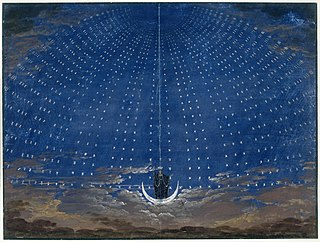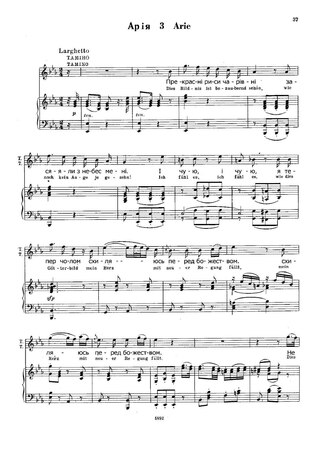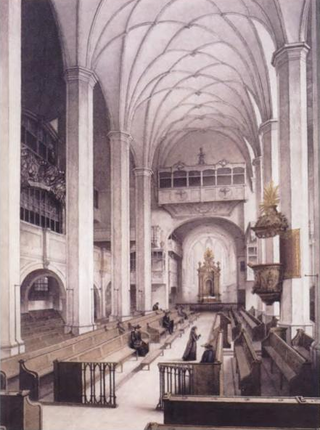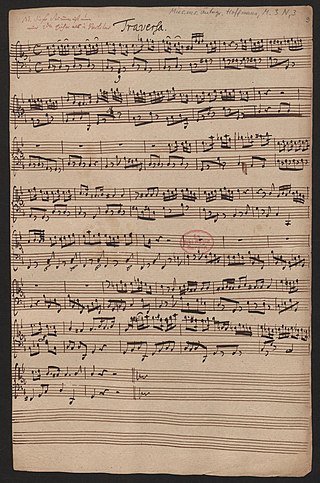
The Magic Flute, K. 620, is an opera in two acts by Wolfgang Amadeus Mozart to a German libretto by Emanuel Schikaneder. The work is in the form of a Singspiel, a popular form during the time it was written that included both singing and spoken dialogue. The work premiered on 30 September 1791 at Schikaneder's theatre, the Freihaus-Theater auf der Wieden in Vienna, just two months before the composer's premature death. Still a staple of the opera repertory, its popularity was reflected by two immediate sequels, Peter Winter's Das Labyrinth oder Der Kampf mit den Elementen. Der Zauberflöte zweyter Theil (1798) and a fragmentary libretto by Johann Wolfgang von Goethe titled The Magic Flute Part Two.

Die Entführung aus dem Serail is a singspiel in three acts by Wolfgang Amadeus Mozart. The German libretto is by Gottlieb Stephanie, based on Christoph Friedrich Bretzner's Belmont und Constanze, oder Die Entführung aus dem Serail. The plot concerns the attempt of the hero Belmonte, assisted by his servant Pedrillo, to rescue his beloved Constanze from the seraglio of Pasha Selim. The work premiered on 16 July 1782 at the Vienna Burgtheater, with the composer conducting.

Die Fledermaus is an operetta composed by Johann Strauss II to a German libretto by Karl Haffner and Richard Genée, which premiered in 1874.

La clemenza di Tito, K. 621, is an opera seria in two acts composed by Wolfgang Amadeus Mozart to an Italian libretto by Caterino Mazzolà, after Pietro Metastasio. It was started after most of Die Zauberflöte, the last of Mozart's principal operas, had already been written. The work premiered on 6 September 1791 at the Estates Theatre in Prague.

Il re pastore is an opera, K. 208, written by Wolfgang Amadeus Mozart to an Italian libretto by Metastasio, edited by Giambattista Varesco. It is an opera seria. The opera was first performed on 23 April 1775 in Salzburg in the Rittersaal of the Residenz-Theater in the palace of the Archbishop Count Hieronymus von Colloredo.

Die Schuldigkeit des ersten Gebots, K. 35, is a sacred musical play composed by Wolfgang Amadeus Mozart in 1767 when he was 11 years old. It is Mozart's first opera or, more specifically, sacred drama, as is suggested by the name. The libretto is now attributed to Ignatz Anton von Weiser, although Johann Adam Wieland or Jakob Anton Marianus Wimmer had been suggested earlier. Only the first part of the opera was composed by Mozart; the second and third parts were contributed by Michael Haydn and Anton Cajetan Adlgasser respectively. However, these other two parts have not survived. Part 1 of the opera was first performed on March 12, 1767, in the Knight's Hall of the Palace of the Archbishop, the Salzburg Residenz. Part 2 was performed on March 19, and part 3 on March 26.

Oberon, or The Elf-King's Oath is a 3-act romantic opera with spoken dialogue composed in 1825–26 by Carl Maria von Weber. The only English opera ever set by Weber, the libretto by James Robinson Planché was based on the German poem Oberon by Christoph Martin Wieland, which itself was based on the epic romance Huon de Bordeaux, a French medieval tale. It was premiered in London on 12 April 1826.

Le devin du village is a one-act French opera (intermède) by Jean-Jacques Rousseau, who also wrote the libretto. It was the first work in the repertory of the Académie Royale de Musique for which the text and music were by the same author.

"Dies Bildnis ist bezaubernd schön" is an aria from Wolfgang Amadeus Mozart's 1791 opera The Magic Flute. The aria takes place in act 1, scene 1, of the opera. Prince Tamino has just been presented by the Three Ladies with an image of the princess Pamina, and falls instantly in love with her.
Der Golem is an opera in three acts by composer Eugen d'Albert. The work uses a German language libretto by Ferdinand Lion after Arthur Holitscher's 1908 play Der Golem: Ghettolengende in drei Aufzügen. The opera premiered on 14 November 1926 at the Oper Frankfurt, conducted by Clemens Krauss.

Der Rauchfangkehrer, oder Die Unentbehrlichen Verräther ihrer Herrschaften aus Eigennutz is an opera in three acts by Antonio Salieri to a German libretto by Leopold Auenbrugger. Originally designated as a Musikalisches Lustspiel, the work has the characteristics of both a German Singspiel and an Italian opera buffa.

Falstaff, ossia Le tre burle is a dramma giocoso in two acts by Antonio Salieri, set to a libretto by Carlo Prospero Defranceschi after William Shakespeare's The Merry Wives of Windsor.

Der Zarewitsch is an operetta in three acts by Franz Lehár. The German libretto by Heinz Reichert and Bela Jenbach is based on the play of the same name by Polish author Gabriela Zapolska. Lehár composed the work, one of his later operettas, as a vehicle for Richard Tauber, the acclaimed Austrian tenor. The work received its first performance at the Deutsches Künstlertheater in Berlin on 16 February 1927, with Tauber and Rita Georg in the leading roles.

Günther von Schwarzburg is a Singspiel in three acts by Ignaz Holzbauer set to a German libretto by Anton Klein. Loosely based on events in the life of the 14th-century German king, Günther von Schwarzburg, the opera premiered on 5 January 1777 at the Hoftheater in the Mannheim Palace.

Die Rheinnixen is a romantic opera in four acts by Jacques Offenbach. The original libretto by Charles-Louis-Étienne Nuitter was translated into German by Alfred von Wolzogen.

Johann Sebastian Bach composed the church cantata Ich geh und suche mit Verlangen, BWV 49, in Leipzig for the twentieth Sunday after Trinity Sunday and first performed it on 3 November 1726. It is a solo cantata, a dialogue of soprano and bass.
Meine Seele rühmt und preist, BWV 189, is a church cantata credited to Johann Sebastian Bach and Melchior Hoffmann.

Georg Melchior Hoffmann was a Baroque composer who was influential as the leader at the Collegium Musicum in Leipzig. Some of his compositions have been mistaken for those of Johann Sebastian Bach.
Vera Schoenenberg is a German soprano in opera, operetta, Lied and oratorio, and a lecturer at the Mozarteum University Salzburg.















